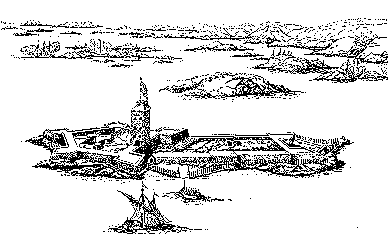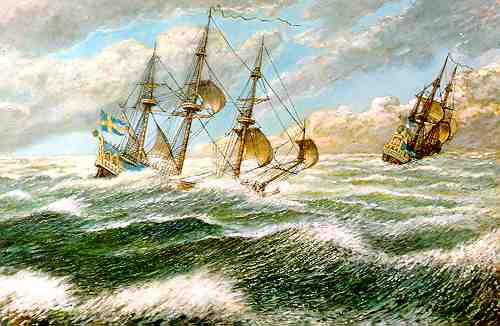

Greetings to all our friends in the USA - with a special reference to the Kalmar Nyckel Project in Wilmington - from Gothenburg, Sweden.
All paintings © by: Lars Gillis. Webmaster: Jan-Erik Nilsson
This page was created by me in 1989, in the early days of the East Indiaman Gotheborg III project, as a part of utilizing the new media - the Internet - to connect with similar ship building projects around the world.

In November 1637 the ship "Kalmar Nyckel" sailed by the old Elfsborg Castle in the Gothenburg harbor on her first trip to establish a new foothold and possible a trade outpost of The New Sweden in America.
Eight canon shots were fired as a salute as she passed.
In the year of 1612 the Elfsborg Castle were captured by the Danish and kept as pledge for a large piece of land in Western Sweden. The Swedes had to pay the enormous amount of 1 million Riksdaler Specie to redeem the land. The money was delivered in four installments. The three firsts in 1616, 1617 and 1618 were paid on Elfsborg Castle. In 1619 the King Gustav Adolf II visited the Elfsborg Castle, which by then was an empty shell.
Eighteen years later in 1637, at the time of the departure of the Kalmar Nyckel, it was reestablished to as strong a fortress it would ever be.
The Danish who must have thought it was an excellent business idea to capture the Swedish Castle of Elfsborg and sell it back to the Swedes, had by 1644 decided it was time to have a go at it again. However, in 1644 the Elfsborg Castle had lost its strategic value because of the increase of the artillery range and firepower. This time the city was defended much further out, in the Elfsborg Fjord, to be more specific, at the New Elfsborg Castle. Incidentally exactly on the spot where the East Indiaman Gotheborg would founder 100 years later.

The Kalmar Nyckel who was 33 meters long at the waterline were part of the Swedish Navy as the Gothenborg Squadron. She was built to carry a large burden but despite this known to be a good and fast ship.
The soldiers were onboard a second ship - the Fågel Grip - a slightly smaller ship, most probably a Pinnace.

The Kings messenger is telling the peasants they are no longer allowed to make new farmland by firing the forests. All forests are needed by the war efforts to make charcoal for gunpowder. The peasants are worried - how will we now be able to support our growing families on our small farms?
The emigrants that sailed with the ships were possibly forced volunteers. The common practice of making new farmland was to set the forest on fire and plant seeds in the ash.
During the Kalmar war (1611-12) this way of farming was forbidden. The woods were needed for charcoal, to make iron, to canon casting and for gunpowder.
Outside the church the royal proclamation were read for the astonished farmers who no longer would be able to support their growing families...


Soldiers escorting the emigrating Swedish farmers to Gothenburg by the end of the 1640:s. The view is from where the Vasagatan in Gothenburg is today. (Detail)



Fogel Grip, to the left, and Kalmar Nyckel, to the right soon were hit by a severe storm in the North Sea on their way to New Sweden in 1637. They sailed were the winds took them and they ended up in Holland were they could have the damages to the ships and riggings repaired. In the New Years day of 1638 they were able to proceed.


The Swedish farmers brought their way of farming with them to their new homeland. Their pigs were let loose and were hunted when the need for pork arose. The only problem was that the locals, the native Americans, also developed a taste for imported pork.

Click here to visit The Kalmar Nyckel Foundation, Wilmington, Delaware, USA!
Click here to return to gotheborg.com!
